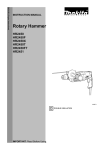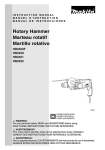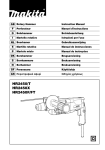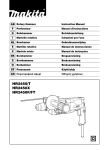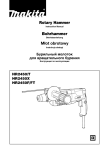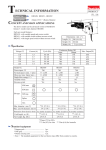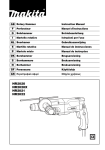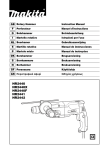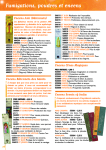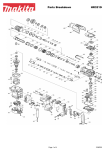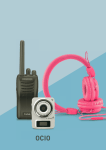Download Makita HR2451 Specifications
Transcript
ENGLISH Rotary Hammer MODEL HR2450 MODEL HR2450F MODEL HR2450X MODEL HR2450T MODEL HR2450FT MODEL HR2451 003571 DOUBLE INSULATION I N S T R U C T I O N M A N U A L WARNING: For your personal safety, READ and UNDERSTAND before using. SAVE THESE INSTRUCTIONS FOR FUTURE REFERENCE. SPECIFICATIONS Model HR2450/HR2450X/HR2450F/HR2451 HR2450T/HR2450FT Tungsten-carbide tipped bit 24 mm Core bit 54 mm Diamond core bit 65 mm Concrete Capacities Steel 13 mm Wood 32 mm No load speed (min-1) 0 - 1,100 Blows per minute 0 - 4,500 Overall length 360 mm Net weight 2.4 kg Safety class 384 mm 2.6 kg /II • Due to our continuing programme of research and development, the specifications herein are subject to change without notice. • Note: Specifications may differ from country to country. SYMBOLS END201-1 The following show the symbols used for the tool. Be sure that you understand their meaning before use. ...................Read instruction manual. ...................DOUBLE INSULATION Intended use The tool is intended for hammer drilling and drilling in brick, concrete and stone as well as for chiselling work. It is also suitable for drilling without impact in wood, metal, ceramic and plastic. Power supply The tool should be connected only to a power supply of the same voltage as indicated on the nameplate, and can only be operated on single-phase AC supply. They are double-insulated in accordance with European Standard and can, therefore, also be used from sockets without earth wire. 2 For European countries only Noise and Vibration The typical A-weighted noise levels are sound pressure level: 89 dB (A) sound power level: 102 dB (A) – Wear ear protection. – The typical weighted root mean square acceleration value is 9.0 m/s2. EC-DECLARATION OF CONFORMITY We declare under our sole responsibility that this product is in compliance with the following standards of standardized documents, HD400, EN50144, EN55014, EN61000 in accordance with Council Directives, 73/23/ EEC, 89/336/EEC, 98/37/EC. Yasuhiko Kanzaki CE 2002 Director MAKITA INTERNATIONAL EUROPE LTD. Michigan Drive, Tongwell, Milton Keynes, Bucks MK15 8JD, ENGLAND SAFETY INSTRUCTIONS ENA001-2 WARNING: When using electric tools, basic safety precautions, including the following, should always be followed to reduce the risk of fire, electric shock and personal injury. Read all these instructions before operating this product and save these instructions. For safe operations: 1. Keep work area clean. Cluttered areas and benches invite injuries. 2. Consider work area environment. Do not expose power tools to rain. Do not use power tools in damp or wet locations. Keep work area well lit. Do not use power tools where there is risk to cause fire or explosion. Guard against electric shock. Avoid body contact with earthed or grounded surfaces (e.g. pipes, radiators, ranges, refrigerators). Keep children away. Do not let visitors touch the tool or extension cord. All visitors should be kept away from work area. Store idle tools. When not in use, tools should be stored in a dry, high or locked up place, out of reach of children. Do not force the tool. It will do the job better and safer at the rate for which it was intended. Use the right tool. Do not force small tools or attachments to do the job of a heavy duty tool. Do not use tools for purposes not intended; for example, do not use circular saws to cut tree limbs or logs. Dress properly. Do not wear loose clothing or jewellery, they can be caught in moving parts. Rubber gloves and non-skid footwear are recommended when working outdoors. Wear protecting hair covering to contain long hair. Use safety glasses and hearing protection. Also use face or dust mask if the cutting operation is dusty. Connect dust extraction equipment. If devices are provided for the connection of dust extraction and collection facilities ensure these are connected and properly used. Do not abuse the cord. Never carry the tool by the cord or yank it to disconnect it from the socket. Keep the cord away from heat, oil and sharp edges. Secure work. Use clamps or a vice to hold the work. It is safer than using your hand and it frees both hands to operate the tool. Do not overreach. Keep proper footing and balance at all times. Maintain tools with care. Keep cutting tools sharp and clean for better and safer performance. Follow instructions for lubrica- 3. 4. 5. 6. 7. 8. 9. 10. 11. 12. 13. 14. 15. 16. 17. 18. 19. 20. 21. 22. tion and changing accessories. Inspect tool cord periodically and if damaged have it repaired by an authorized service facility. Inspect extension cords periodically and replace, if damaged. Keep handles dry, clean and free from oil and grease. Disconnect tools. When not in use, before servicing and when changing accessories such as blades, bits and cutters. Remove adjusting keys and wrenches. Form the habit of checking to see that keys and adjusting wrenches are removed from the tool before turning it on. Avoid unintentional starting. Do not carry a plugged-in tool with a finger on the switch. Ensure switch is off when plugging in. Use outdoor extension leads. When tool is used outdoors, use only extension cords intended for outdoor use. Stay alert. Watch what you are doing. Use common sense. Do not operate tool when you are tired. Check damaged parts. Before further use of the tool, a guard or other part that is damaged should be carefully checked to determine that it will operate properly and perform its intended function. Check for alignment of moving parts, free running of moving parts, breakage of parts, mounting and any other conditions that may affect its operation. A guard or other part that is damaged should be properly repaired or replaced by an authorized service center unless otherwise indicated in this instruction manual. Have defective switches replaced by an authorized service facility. Do not use the tool if the switch does not turn it on and off. Warning. The use of any accessory or attachment, other than those recommended in this instruction manual or the catalog, may present a risk of personal injury. Have your tool repaired by a qualified person. This electric tool is in accordance with the relevant safety requirements. Repairs should only be carried out by qualified persons using original spare parts, otherwise this may result in considerable danger to the user. 3 ADDITIONAL SAFETY RULES FOR TOOL 1. Hold tools by insulated gripping surfaces when performing an operation where the cutting tool may contact hidden wiring or its own cord. Contact with a “live” wire will make exposed metal parts of the tool “live” and shock the operator. 2. Wear ear protectors when using the tool for extended periods. Prolonged exposure to high intensity noise can cause hearing loss. Wear a hard hat (safety helmet), safety glasses and/or face shield. It is also highly recommended that you wear a dust mask and thickly padded gloves. Be sure the bit is secured in place before operation. Under normal operation, the tool is designed to produce vibration. The screws can come loose easily, causing a breakdown or accident. Check tightness of screws carefully before operation. 3. 4. 5. 6. In cold weather or when the tool has not been used for a long time, let the tool warm up for a while by operating it under no load. This will loosen up the lubrication. Without proper warmup, hammering operation is difficult. 7. Always be sure you have a firm footing. Be sure no one is below when using the tool in high locations. 8. Hold the tool firmly with both hands. 9. Keep hands away from moving parts. 10. Do not leave the tool running. Operate the tool only when hand-held. 11. Do not point the tool at any one in the area when operating. The bit could fly out and injure someone seriously. 12. Do not touch the bit or parts close to the bit immediately after operation; they may be extremely hot and could burn your skin. SAVE THESE INSTRUCTIONS 4 ENB010-1 FUNCTIONAL DESCRIPTION • 001292 CAUTION: Always be sure that the tool is switched off and unplugged before adjusting or checking function on the tool. Switch action CAUTION: Before plugging in the tool, always check to see that the switch trigger actuates properly and returns to the “OFF” position when released. To start the tool, simply pull the switch trigger. Tool speed is increased by increasing pressure on the switch trigger. Release the switch trigger to stop. For continuous operation, pull the switch trigger and then push in the lock button. To stop the tool from the locked position, pull the switch trigger fully, then release it. • 1 2 1. Switch trigger 2. Lock button Lighting up the lamps 003572 For model HR2450F/HR2450FT CAUTION: • Do not look in the light or see the source of light directly. To turn on the lamp, pull the trigger. Release the trigger to turn it off. NOTE: • 1 Use a dry cloth to wipe the dirt off the lens of lamp. Be careful not to scratch the lens of lamp, or it may lower the illumination. 1. Lamp 001293 A 1 B 2 Reversing switch action For Model HR2450,HR2450F,HR2450X,HR2450T and HR2450FT This tool has a reversing switch to change the direction of rotation. Move the reversing switch lever to the position (A side) for clockwise rotation or the position (B side) for counterclockwise rotation. • • 1. Switch trigger 2. Reversing switch lever • CAUTION: Always check the direction of rotation before operation. Use the reversing switch only after the tool comes to a complete stop. Changing the direction of rotation before the tool stops may damage the tool. When you operate the tool in counterclockwise rotation, the switch trigger is pulled only halfway and the tool runs at half speed. For counterclockwise rotation, you cannot push in the lock button. 5 004415 1 2 3 Changing the quick change chuck for SDS-plus For model HR2450T/HR2450FT The quick change chuck for SDS-plus can be easily exchanged for the quick change drill chuck. Removing the quick change chuck for SDS-plus CAUTION: Before removing the quick change chuck for SDS-plus, always remove the bit. Grasp the change cover of the quick change chuck for SDS-plus and turn in the direction of the arrow until the change cover line moves from the symbol to the symbol to the <RHAM Unlock> symbol. Pull forcefully in the direction of the arrow. • 1. Quick change chuck for SDS-plus 2. Change cover line 3. Change cover 004416 1 2 3 Attaching the drill quick change drill chuck Check the line of the quick change drill chuck shows the symbol. Grasp the change cover of the quick change drill chuck and set the line to the symbol. Place the quick change drill chuck on the spindle of the tool. Grasp the change cover of the quick change drill chuck and turn the change cover line to the symbol until a click can clearly be heard. 4 1. 2. 3. 4. Quick change drill chuck Change cover line Change cover Spindle Selecting the action mode 003573 1 2 Rotation with hammering For drilling in concrete, masonry, etc., depress the lock button and rotate the action mode changing knob to the symbol. Use a tungsten-carbide tipped bit. 3 1. Rotation with hammering 2. Lock button 3. Action mode changing knob 003575 1 1. Rotation only 6 Rotation only For drilling in wood, metal or plastic materials, depress the lock button and rotate the action mode changing knob to the symbol. Use a twist drill bit or wood bit. 003574 1 Hammering only For chipping, scaling or demolition operations, depress the lock button and rotate the action mode changing knob to the symbol. Use a bull point, cold chisel, scaling chisel, etc. • • 1. Hammering only CAUTION: Do not rotate the action mode changing knob when the tool is running under load. The tool will be damaged. To avoid rapid wear on the mode change mechanism, be sure that the action mode changing knob is always positively located in one of the three action mode positions. Torque limiter The torque limiter will actuate when a certain torque level is reached. The motor will disengage from the output shaft. When this happens, the bit will stop turning. • • ASSEMBLY • 001295 4 1 2 3 1. 2. 3. 4. 5. 6. 6 CAUTION: As soon as the torque limiter actuates, switch off the tool immediately. This will help prevent premature wear of the tool. Hole saws cannot be used with this tool. They tend to pinch or catch easily in the hole. This will cause the torque limiter to actuate too frequently. CAUTION: Always be sure that the tool is switched off and unplugged before carrying out any work on the tool. Side grip (auxiliary handle) 5 CAUTION: • Always use the side grip to ensure operating safety. Install the side grip so that the teeth on the grip fit in between the protrusions on the tool barrel. Then tighten the grip by turning clockwise at the desired position. It may be swung 360° so as to be secured at any position. Grip base Side grip Loosen Teeth Protrusion Tighten Bit grease Coat the bit shank head beforehand with a small amount of bit grease (about 0.5 - 1 g). This chuck lubrication assures smooth action and longer service life. 7 001296 Installing or removing the bit Clean the bit shank and apply bit grease before installing the bit. 1 2 1. Bit shank 2. Bit grease 001297 Insert the bit into the tool. Turn the bit and push it in until it engages. After installing, always make sure that the bit is securely held in place by trying to pull it out. 001298 To remove the bit, pull the chuck cover down all the way and pull the bit out. 003576 Bit angle (when chipping, scaling or demolishing) 1 2 1. Bit 2. Chuck cover 1 2 1. Bit 2. Chuck cover The bit can be secured at the desired angle. To change the bit angle, depress the lock button and rotate the action mode changing knob to the O symbol. Turn the bit to the desired angle. 1 1. Action mode changing knob 2. Lock button 8 2 003577 Depress the lock button and rotate the action mode changing knob to the symbol. Then make sure that the bit is securely held in place by turning it slightly. 001299 Depth gauge The depth gauge is convenient for drilling holes of uniform depth. Loosen the side grip and insert the depth gauge into the hole in the side grip. Adjust the depth gauge to the desired depth and tighten the side grip. 1 NOTE: • The depth gauge cannot be used at the position where the depth gauge strikes against the gear housing. 1. Depth gauge 001300 1 Dust cup Use the dust cup to prevent dust from falling over the tool and on yourself when performing overhead drilling operations. Attach the dust cup to the bit as shown in the figure. The size of bits which the dust cup can be attached to is as follows. C00022 Bit diameter Dust cup 5 6 mm - 14.5 mm Dust cup 9 12 mm - 16 mm 1. Dust cup OPERATION 003579 Hammer drilling operation Set the action mode changing knob to the symbol. Position the bit at the desired location for the hole, then pull the switch trigger. Do not force the tool. Light pressure gives best results. Keep the tool in position and prevent it from slipping away from the hole. Do not apply more pressure when the hole becomes clogged with chips or particles. Instead, run the tool at an idle, then remove the bit partially from the hole. By repeating this several times, the hole will be cleaned out and normal drilling may be resumed. • CAUTION: There is a tremendous and sudden twisting force exerted on the tool/bit at the time of hole break-through, when the hole becomes clogged with chips and particles, or when striking reinforcing rods embedded in the concrete. Always use the side grip (auxiliary handle) and firmly hold the tool by both side grip and switch handle during operations. Failure to do so may result in the loss of control of the tool and potentially severe injury. 9 002449 Blow-out bulb (optional accessory) After drilling the hole, use the blow-out bulb to clean the dust out of the hole. 1 1. Blow-out bulb 003580 Chipping/Scaling/Demolition Set the action mode changing knob to the symbol. Hold the tool firmly with both hands. Turn the tool on and apply slight pressure on the tool so that the tool will not bounce around, uncontrolled. Pressing very hard on the tool will not increase the efficiency. 10 Drilling in wood or metal 004223 1 2 1. Chuck adapter 2. Keyless drill chuck For Model HR2450/HR2450F/HR2450X/HR2451 Use the optional drill chuck assembly. When installing it, refer to “Installing or removing the bit” described on the previous page. For model HR2450T/HR2450FT Use the quick change drill chuck as standard equipment. When installing it, refer to “changing the quick change chuck for SDS-plus” described on the previous page. Hold the ring and turn the sleeve counterclockwise to open the chuck jaws. Place the bit in the chuck as far as it will go. Hold the ring firmly and turn the sleeve clockwise to tighten the chuck. To remove the bit, hold the ring and turn the sleeve counterclockwise. Set the action mode changing knob to the symbol. You can drill up to 13mm diameter in metal and up to 32mm diameter in wood. 004415 1 2 3 • • • 1. Quick change chuck for SDS-plus 2. Change cover line 3. Change cover 004416 1 2 • • CAUTION: Never use “rotation with hammering” when the quick change drill chuck is installed on the tool. The quick change drill chuck may be damaged. Also, the drill chuck will come off when reversing the tool. Pressing excessively on the tool will not speed up the drilling. In fact, this excessive pressure will only serve to damage the tip of your bit, decrease the tool performance and shorten the service life of the tool. There is a tremendous twisting force exerted on the tool/bit at the time of hole breakthrough. Hold the tool firmly and exert care when the bit begins to break through the workpiece. A stuck bit can be removed simply by setting the reversing switch to reverse rotation in order to back out. However, the tool may back out abruptly if you do not hold it firmly. Always secure small workpieces in a vise or similar hold-down device. 3 4 1. 2. 3. 4. Quick change drill chuck Change cover line Change cover Spindle 004224 1 2 3 1. Sleeve 2. Ring 3. Quick change drill chuck 11 Diamond core drilling When performing diamond core drilling operations, always set the change lever to the position to use “rotation only” action. CAUTION: If performing diamond core drilling operations using “rotation with hammering” action, the diamond core bit may be damaged. MAINTENANCE CAUTION: Always be sure that the tool is switched off and unplugged before attempting to perform inspection or maintenance. To maintain product SAFETY and RELIABILITY, repairs, carbon brush inspection and replacement, any other maintenance or adjustment should be performed by Makita Authorized Service Centers, always using Makita replacement parts. • ACCESSORIES CAUTION: These accessories or attachments are recommended for use with your Makita tool specified in this manual. The use of any other accessories or attachments might present a risk of injury to persons. Only use accessory or attachment for its stated purpose. If you need any assistance for more details regarding these accessories, ask your local Makita service center. • • • • • • • • • • 12 SDS-Plus Carbide-tipped bits Bull point Cold chisel Scaling chisel Grooving chisel Drill chuck assembly Drill chuck S13 Chuck adapter Chuck key S13 • • • • • • • • • Bit grease Side grip Depth gauge Blow-out bulb Dust cup Dust extractor attachment Safety goggles Plastic carrying case Keyless drill chuck Memo 13 Memo 14 Memo 15 Makita Corporation 884425D220
















